Technical Data Large size conveyor chain Selection
9. Calculate chain load
Maximum static load to chain, Tmax, during operation can be calculated using the formulae in Table 3.
The formulae are based on mass M (weight W) × coefficient of friction.
Inertial forces are extremely large when suddenly starting or stopping high speed conveyors or when rapidly conveying items using push conveyors or other such systems. Bear these inertial forces in mind when calculating the load and required kW.
Calculations are listed in both SI units and gravimetric units. When calculating tension T in gravimetric units, the mass value (kgf) is the same as the mass value for SI units (kg).
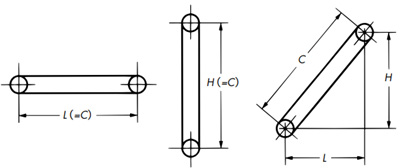
9.1 Description of terms
| SI Unit | Gravity unit | ||
|---|---|---|---|
| TMAX | Maximum static load on chain | kN | {kgf} |
| T'MAX | Design chain tension | kN | {kgf} |
| T | Static load on chain | kN | {kgf} |
| Q | Maximum conveying quantity | t/h | {tf/h} |
| V | Conveying speed (Chain speed ) | m/min | m/min |
| H | Center distance between sprockets (vertical direction ) | m | m |
| L | Center distance between sprockets (horizontal direction ) | m | m |
| C | Center distance between sprockets | m | m |
| M | Mass {weight} of moving parts {Weight } (Chain × strands, buckets, aprons, etc. {Weight }) |
kg/m | {kgf/m} |
| f1 | Coefficient of friction between chain and guide rail (Table 5, Table 6) | ||
| f2 | Coefficient of friction between material conveyed and casing (Table 7) | ||
| f | Material loaded directly on chain f=1 Material scraped f=f2/f1 | ||
| g | Gravitational acceleration 9.80665m/s2 | ||
| W | Weight of conveyed goods {Weight } Bulk items W=16.7Note ×Q/V {W=16.7×Q/V} Solid Conveyance W=Weight of conveyed goods (kg/piece(s))/Loading interval (m) {W=Mass Conveyed Item (kgf/each )/Loading interval (m)} |
kg/m | {kgf/m} |
Note) The coefficient for calculating the mass (weight) per meter of item conveyance is 16.7=1000/60
※If frequent forward and reverse operation is required, take-up is necessary to remove chain slack, so the calculation differs from the below.
When removing slack in a chain by take-up, please use the calculation formula in Q&A6.
9.2Calculate Chain Load (Table 3)
| SI Unit | {Gravity unit } | |||||||||||||||||||||||||||||||||||||||||||||||||||||
|---|---|---|---|---|---|---|---|---|---|---|---|---|---|---|---|---|---|---|---|---|---|---|---|---|---|---|---|---|---|---|---|---|---|---|---|---|---|---|---|---|---|---|---|---|---|---|---|---|---|---|---|---|---|---|
|
Horizontal conveyance 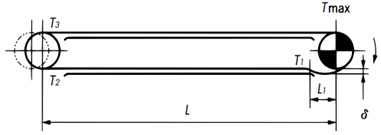
T1 = 1.35 ※1 × M × L1 × g 1000 ......kN T2 = ( L - L1) × M × f1 × g 1000 + T1 ......kN T3 = 1.1 ※2 × T2 ......kN TMAX = (W × f + M ) × L × f1 × g 1000 + T3 ......kN T1 = 1.35 × M × L1 ......{kgf} T2 = ( L - L1) × M × f1 + T1 ......{kgf} T3 = 1.1 × T2 ......{kgf} TMAX = (W × f + M ) × L × f1 + T3 ......{kgf}
|
||||||||||||||||||||||||||||||||||||||||||||||||||||||
|
Horizontal conveyance 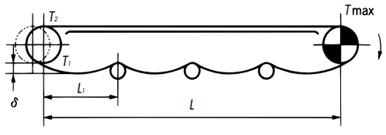
T1 = 1.35 × M × L1× g 1000 + 0.1※ × M × L × g 1000 ......kN T2 = 1.1 × T1 ......kN TMAX = (W × f + M) × L × f1 × g 1000 + T2 ......kN T1 = 1.35 × M × L1 + 0.1※ × M × L ......{kgf} T2 = 1.1 × T1 ......{kgf} TMAX = (W × f + M) × L × f1 ......{kgf}
|
||||||||||||||||||||||||||||||||||||||||||||||||||||||
|
Vertical conveyance 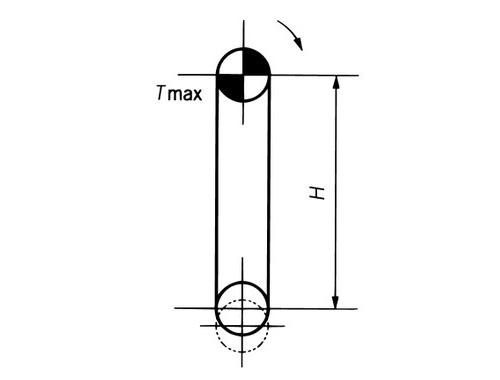
TMAX = (W + M) × H × g 1000 + WT 2 × g 1000 ......kN TMAX = (W + M) × H + WT 2 ......{kgf} |
||||||||||||||||||||||||||||||||||||||||||||||||||||||
|
Inclined conveyance 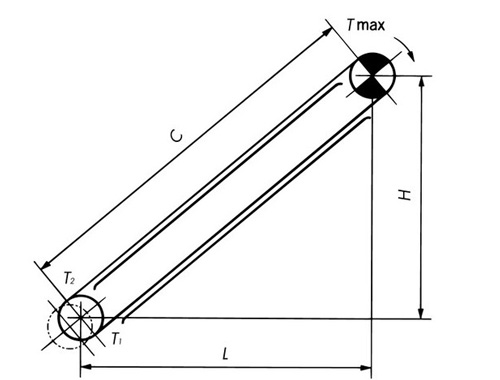
T1 = M(Lf1 - H) × g 1000 ......kN When T1<0, T2=0 T2 = 1.1 × T1 ......kN TMAX = W(Lf1 × f + H) × g 1000 + M(Lf1 + H) × g 1000 + T2 ......kN T1 = M(Lf1 - H) ......{kgf} When T1<0, T2=0 T2 = 1.1 × T1 ......{kgf} TMAX = W(Lf1 × f + H) + M(Lf1 + H) + T2 ......{kgf} |
||||||||||||||||||||||||||||||||||||||||||||||||||||||
|
Practical Example 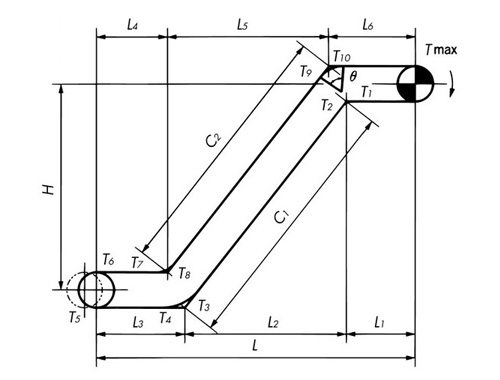
T1= M × L1 × f1 × g 1000 ......kN T2= T1× Kc1 ......kN T3= M(L2f1 - H) × g 1000 + T2 ......kN T4= T3× Kc2 ......kN When T3<0, T4=0 T5= M × L3 × f1 × g 1000 + T4 ......kN T6= 1.1 × T5 ......kN T7= (M + W × f) × L4 × f1 × g 1000 + T6 ......kN T8= T7× Kc3 ......kN T9= W(L5f1 × f + H) × g 1000 + M(L5f1 + H) × g 1000 + T8 ......kN T10 = T9× Kc4 ......kN TMAX = (M + W × f) × L6 × f1 × g 1000 + T10 ......kN Corner Factor Kc
T1 = M × L1 × f1 ......{kgf} T2 = T1 × Kc1 ......{kgf} T3 = M(L2f1 - H) + T2 ......{kgf} T4 = T3 × Kc2 ......{kgf} When T3<0, T4=0 T5 = M × L3 × f1 + T4 ......{kgf} T6 = 1.1 × T5 ......{kgf} T7 = (M + W × f) × L4 × f1 + T6 ......{kgf} T8 = T7 × Kc3 ......{kgf} T9 = W(L5f1 × f + H) + M(L5f1 + H) + T8 ......{kgf} T10 = T9 × Kc4 ......{kgf} TMAX = (M + W × f) × L6 × f1 + T10 ......{kgf} |
||||||||||||||||||||||||||||||||||||||||||||||||||||||
|
Example using Double Plus Chain 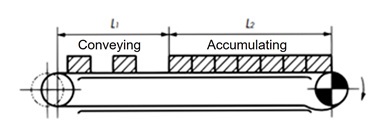
TMAX = 2.1M(L1 + L2) f1 ×
g
1000
+ (W × L1 × f1) TMAX = 2.1M(L1 + L2) f1 + (W × L1 × f1) + (W1 × L2 × f3) ......{kgf}
|
||||||||||||||||||||||||||||||||||||||||||||||||||||||
|
Chain load T for calculating required power can be obtained from the following formulae: Horizontal T = TMAX - T1 Vertical T = TMAX - MH × g 1000 Inclined T = TMAX - M(H - Lf1) × g 1000 T = TMAX - MH T = TMAX - M(H - Lf1)
・Calculating Required Power 1kW = 1kN・m/s kW = T × V 60 1kW = 102kgf・m/s kW = T × V 102 × 60 Assuming that the power loss from chain–sprocket engagement and sprocket rotational friction resistance to be 10% (1/0.9 = 1.1) When the power transmission ratio of the drive section is η, kW = T × V 60 × 1.1 × 1 η kW = T × V 102 × 60 × 1.1 × 1 η |
||||||||||||||||||||||||||||||||||||||||||||||||||||||
Table 4. Catenary Load Graph
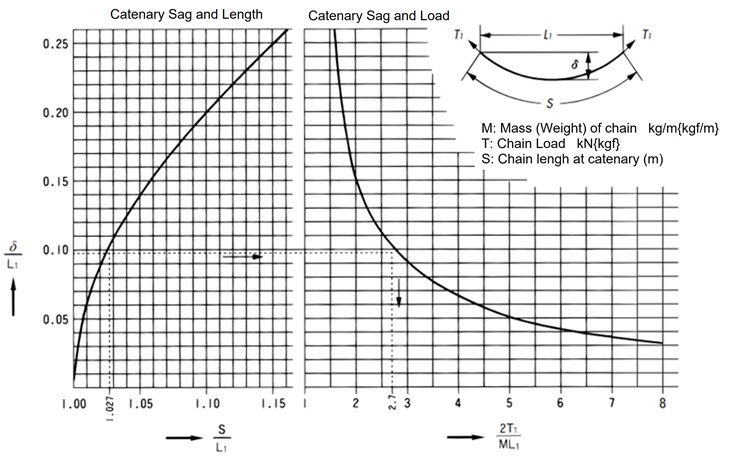
Catenary Load
T1 = 1.35 × M × L1 × g 1000 ......kN
1.35 factor in the above formula is worked out as follows:
When catenary sag is 10%, δ = 0.10L1
Then from the graph
δ
L1
= 0.10 →
2T1
ML1
= 2.7
T1 = 1.35 × M × L1 ×
g
1000
Chain Length at Catenary
δ L1 = 0.10 → S L1 = 1.027
S = 1.027L1
Table 5.Rolling Friction Factor f1 Between Chain and Rail f1
| Roller Diameter (mm) |
Lubricated | Dry | ||
|---|---|---|---|---|
| R, F-roller | S,M,N-roller | R, F-roller | S,M,N-roller | |
| D<65 | 0.08 | 0.16 | 0.15 | 0.24 |
| 65≦D<100 | 0.08 | 0.15 | 0.14 | 0.23 |
| 100≦D | 0.08 | 0.14 | 0.13 | 0.22 |
| RF-214(exception) | 0.12 | 0.15 | 0.18 | 0.22 |
Note)
- 1. Lubricant ISO VG100–150 (SAE30–40)
- 2. Conditions: Clean and room temperature
- 3. The friction factor f1 between top roller and material conveyed is the same as that of R roller in the above.
| Series | f1 |
|---|---|
| Plastic Roller Series | 0.08(No lubrication required ) |
| Bearing Roller Series | 0.03(Lubricated ) |
| Bearing Bush Series | 0.14(Lubricated ), 0.21(Dry ) |
| EPC78 | 0.1(Lubricated ), 0.2(water-lubricated ), 0.25(Dry ) |
Table 6.Sliding Coefficient of Friction f1 Between Chain and Rail f1
| Temperature of Conveyed Material ℃ | Lubricated | Dry |
|---|---|---|
| Ambient Temperature ~400 | 0.20 | 0.30 |
| 400~600 | 0.30 | 0.35 |
| 600~800 | 0.35 | 0.40 |
| 800~1000 | - | 0.45 |
Table 7.Coefficient of Friction f2 Between Material Conveyed and Casing f2
| Conveyed object | f2 | Apparent Specific Gravity |
|---|---|---|
| Scale | 0.67 | 1.54 |
| Red iron ore | 0.47 | 2.99 |
| Pyrites | 0.58 | 1.54 |
| Slag | 0.48 | 0.90 |
| Scrap | 0.73 | 0.54 |
| Lead ore powder | 0.77 | 3.26 |
| Zinc ore powder | 0.79 | 1.93 |
| Nickel ore powder | 0.45 | 0.92 |
| Chrome powder | 0.51 | 1.14 |
| Alumina | 0.55 | 0.83 |
| Magnesia | 0.84 | 1.48 |
| Gypsum | 0.64 | 0.77 |
| Quartz powder | 0.55 | 1.24 |
| Feldspar | 0.55 | 1.36 |
| Dolomite | 0.55 | 1.62 |
| Clay | 0.63 | 0.77 |
| Foundry Sand | 0.41 | 1.59 |
| Phosphate rock | 0.42 | 1.51 |
| Quicklime | 0.46 | 1.53 |
| Slaked lime | 0.63 | 0.69 |
| Asbestos | 0.58 | 0.19 |
| Limestone | 0.47 | 0.35~0.55 |
| Cement | 0.54 | 0.60~0.75 |
| Cement Clinker | 0.46 | 1.30 |
| Charcoal | 0.41 | 0.44 |
| Carbon | 0.53 | 0.30 |
| Pitch | 0.41 | 0.70 |
| Soda Ash | 0.45 | 0.52 |
| Alum | 0.63 | 1.01 |
| Polyethylene | 0.52 | 0.34 |
| Rubber powder | 0.53 | 0.39 |
| Soap material | 0.27 | 0.65 |
| Urea | 0.63 | 0.64 |
| Ammonium chloride | 0.79 | 0.67 |
| Calcium chloride | 0.43 | 0.68 |
| Sulphurated calcium | 0.64 | 1.01 |
| Calcium carbonate | 0.49 | 0.88 |
| Wood chip | 0.74 | 0.36 |
| Rice | 0.4 | 0.77 |
| Barley | 0.71 | 0.39 |
| Wheat | 0.43 | 0.73 |
| Soybean | 0.41 | 0.68 |
| Corn | 0.4 | 0.71 |
| Starch | 0.57 | 0.71 |
| Sugar | 0.47 | 0.68 |
| Rock Salt | 0.57 | 1.09 |
| Mixed Feed | 0.5 | 0.55 |
| Coal | - | 0.30~0.70 |
| Coke | - | 0.30~0.70 |
Note) The above values may change depending on dryness and humidity

